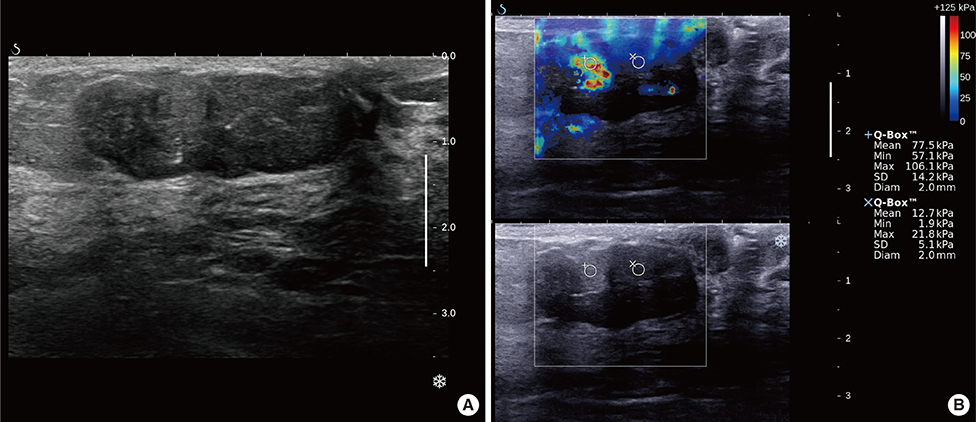J Breast Cancer.
2014 Jun;17(2):180-183.
Ductal Carcinoma In Situ Detected by Shear Wave Elastography within a Fibroadenoma
- Affiliations
-
- 1Department of Radiology, Istanbul University Cerrahpasa Medical Faculty, Istanbul, Turkey. ustabasioglu@hotmail.com
- 2Department of General Surgery, Istanbul University Cerrahpasa Medical Faculty, Istanbul, Turkey.
- 3Department of Pathology, Istanbul University Cerrahpasa Medical Faculty, Istanbul, Turkey.
Abstract
- Fibroadenoma is the most common breast tumor in women. Malignant transformation occurs rarely within fibroadenoma at older ages. Clinicians, radiologists, and pathologists need to be aware of malignant transformation within fibroadenomas. Radiologic studies play an important role in the diagnosis of fibroadenoma; however, radiologic findings are often nonspecific for malignancy and may appear completely benign. We detected an occult ductal carcinoma in situ that originated inside a fibroadenoma by using shear wave elastography. We report shear wave elastography findings of ductal carcinoma in situ within fibroadenoma and discuss the diagnostic role of this modality.
MeSH Terms
Figure
Reference
-
1. Greenberg R, Skornick Y, Kaplan O. Management of breast fibroadenomas. J Gen Intern Med. 1998; 13:640–645.
Article2. Deschênes L, Jacob S, Fabia J, Christen A. Beware of breast fibroadenomas in middle-aged women. Can J Surg. 1985; 28:372–374.3. Ozzello L, Gump FE. The management of patients with carcinomas in fibroadenomatous tumors of the breast. Surg Gynecol Obstet. 1985; 160:99–104.4. Diaz NM, Palmer JO, McDivitt RW. Carcinoma arising within fibroadenomas of the breast: a clinicopathologic study of 105 patients. Am J Clin Pathol. 1991; 95:614–622.
Article5. Abu-Rahmeh Z, Nseir W, Naroditzky I. Invasive ductal carcinoma within fibroadenoma and lung metastases. Int J Gen Med. 2012; 5:19–21.
Article6. Abe H, Hanasawa K, Naitoh H, Endo Y, Tani T, Kushima R. Invasive ductal carcinoma within a fibroadenoma of the breast. Int J Clin Oncol. 2004; 9:334–338.
Article7. Kuijper A, Preisler-Adams SS, Rahusen FD, Gille JJ, van der Wall E, van Diest PJ. Multiple fibroadenomas harbouring carcinoma in situ in a woman with a family history of breast/ovarian cancer. J Clin Pathol. 2002; 55:795–797.
Article8. Giuseppetti GM, Baldassarre S, Marconi E. Color Doppler sonography. Eur J Radiol. 1998; 27:Suppl 2. S254–S258.
Article9. Yang WT, Tse GM. Sonographic, mammographic, and histopathologic correlation of symptomatic ductal carcinoma in situ. AJR Am J Roentgenol. 2004; 182:101–110.
Article10. del Cura JL, Elizagaray E, Zabala R, Legórburu A, Grande D. The use of unenhanced Doppler sonography in the evaluation of solid breast lesions. AJR Am J Roentgenol. 2005; 184:1788–1794.
Article11. Weidner N, Semple JP, Welch WR, Folkman J. Tumor angiogenesis and metastasis: correlation in invasive breast carcinoma. N Engl J Med. 1991; 324:1–8.
Article12. Tiu CM, Chou YH, Chiou SY, Hsu CY, Chen SP, Chiang HR, et al. Development of a carcinoma in situ in a fibroadenoma: color Doppler sonographic demonstration. J Ultrasound Med. 2006; 25:1335–1338.13. Athanasiou A, Tardivon A, Tanter M, Sigal-Zafrani B, Bercoff J, Deffieux T, et al. Breast lesions: quantitative elastography with supersonic shear imaging: preliminary results. Radiology. 2010; 256:297–303.
Article14. Chang JM, Moon WK, Cho N, Yi A, Koo HR, Han W, et al. Clinical application of shear wave elastography (SWE) in the diagnosis of benign and malignant breast diseases. Breast Cancer Res Treat. 2011; 129:89–97.
Article15. Evans A, Whelehan P, Thomson K, McLean D, Brauer K, Purdie C, et al. Quantitative shear wave ultrasound elastography: initial experience in solid breast masses. Breast Cancer Res. 2010; 12:R104.
Article
- Full Text Links
- Actions
-
Cited
- CITED
-
- Close
- Share
- Similar articles
-
- Diagnostic Performance of Quantitative Shear Wave Ultrasound Elastography for Thyroid Cancer
- Ductal Carcinoma In Situ within a Fibroadenoma: Microcalcifications Identified on Mammography Play a Crucial Role in Diagnosis
- Future of breast elastography
- Non-Invasive Liver Fibrosis Test Using Shear Wave Elastography
- Ultrasound Elastography for Liver Disease with Focus on Hepatic Fibrosis




